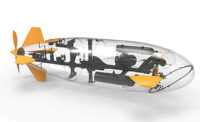Additive manufacturing is transforming the way many types of products are designed and assembled. One industry that’s benefitting the most is aerospace, which traditionally requires complex, low-volume components that must withstand rigorous operating conditions.
Engineers at the Air Force Research Laboratory (AFRL) are at the forefront of developing new applications for printed parts. Current R&D efforts include everything from extreme temperature ceramics to flexible electronics.
“Additive manufacturing is important to the future of aerospace for a variety of reasons,” says Hilmar Koerner, Ph.D., research team lead for polymer matrix composite materials and processes at the AFRL Materials and Manufacturing Directorate. “Benefits include complexity enabled capability; low-volume, low-cost manufacturing; part reduction; improved form-fit function; tool-less part manufacturing; and lightweighting of interior hardware, such as air ducts, seat framework and wall panels.”
Printed parts that hold the most promise for short-term aerospace applications include thermal management systems, such as ducting, heat exchangers and nozzles; embedded functionality items, such as antennae, electronics and wiring; and small engine parts, such as brackets, fixtures and shrouds. Long-term applications include critical, load-bearing structures, such as canopy frames and wing spars.
AFRL engineers are focusing part of their R&D effort on creating new composite manufacturing techniques. “Extrusion-based processes are ideal [for] implementing continuous reinforcement, which is difficult or impossible with other techniques,” Koerner points out.
Traditionally, carbon-fiber composites are made by layering sheets of material coated with epoxy resin that are then baked in an oven for many hours. However, using sheets makes it difficult to create complex-shaped parts.
“Printing composites can produce parts with complex shapes and eliminates the need for the expensive pressure cooker and long heating cycles,” says Jeffery Baur, Ph.D., leader of the AFRL Composite Performance Research Team. “The possibility to produce parts in the field or at a depot without a long logistics tail is a win-win scenario.”
AFRL engineers are using composite printing to make complex core structures which, when combined with top and bottom face sheets, create lightweight sandwich structures with properties tailored to the physical forces that need to be carried.
“Traditional sandwich structures are used on aircraft skins with the same core geometries over the entire area,” explains Baur. “Printing sandwich structures would enable structures that can withstand heavier forces where needed [but] remain lighter weight where they [don’t need to].
“The manufacturing agility of printing cores also allows for the easy insertion of other materials like metal fittings and electrical components which can ease assembly and create multifunctional structures,” says Baur. “[This would enable] embedded sensing, actuation, computation or electrical power for next-generation multifunctional unmanned aerial vehicles.”
Baur, Koerner and their colleagues are also working on numerous challenges that still need to be addressed before additive manufacturing technology is widely used for manned aircraft applications.
“[With additive manufactured composites], measuring the mechanical properties of a printed specimen vs. a conventionally produced specimen is like comparing apples to oranges,” notes Koerner. “Literally, one peels while the other breaks. Printing is creating parts with well-ordered defects. Understanding the effects of these with respect to the global structure is key.
“We have to develop new tools to certify and qualify parts that are made by additive manufacturing,” says Koerner. “[One challenge is] understanding the effect of processing on microstructures and void formation, and the effect on mechanical properties in service life.
“Fatigue and aging of 3D-printed parts and components are affected,” explains Koerner. “Therefore, [most of our current focus is on] nonstructural, noncritical structures and tooling for complex parts.
”Additive manufacturing will not replace conventional manufacturing, but rather complement it in form of function, lightweighting and complexity," claims Koerner. "For example, a wing could be a hybrid of a conventional and 3D-printed [structure] with a topology-optimized core structure that is lightweight and mechanically responsive."




